BLOG
During our stay in Nepal, we held interviews with local police officers and members of the educational community in addition to conducting our usual support activities.
Today, we would like to share with you the results of our findings!
Interviewing the police: do crimes demonstrate a dissatisfaction against the state?
The political climate in Nepal is currently stable in contrast to the fall of the monarchy in 2008. Nevertheless, there are still many crimes being committed, including theft, robbery and drug abuse. Although the police force sends information to schools and conducts periodic orientations meant to encourage students away from crime, their efforts don’t appear to be having much effect. New types of crime such as cyberterrorism and harassment over the internet, are also becoming more commonplace.
At the same time, the police have seen cases of sexual abuse against young girls and infants.
They consider these crimes to demonstrate a dissatisfaction with the way the state is currently being run.
The Nepali police force consider their current communication levels and lack of investigative ability to be their biggest weaknesses. Without proper communication, it is difficult to arrive at the scene of crime or the scene of the accident in time. Regarding investigative ability, we were told about a rape case that occurred 100 days ago in which the police were unable to find incriminating evidence, as the victim’s body and clothing had been washed.
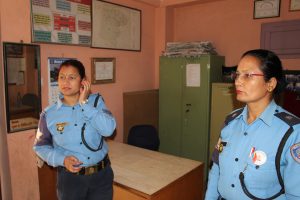
The police officers who spoke with us
Teaching in an academic background-oriented society: what are teachers to students?
In Nepal, a student’s future career is decided based on the results of their SEE (Secondary Education Exam). The highest ranking students move on to science fields, followed by management. However, careers in education are designated for those who scored in the lowest ranking category.
When selecting the educational field, as long as the students scored D or higher in the subjects of Nepali, English, and Social Studies, they can submit a score of E (Fail) in Math. Of course, they would still be required to pass a government exam to acquire a teaching license, but it was shocking to learn that the standards for being accepted as a teacher were so low.
On the other hand, private school teachers are considered very valuable, to the point of being scouted by schools. This may be one of the reasons why private schools are considered to provide a better education than public schools, just like Japan. However, since private schools take good care of their students, the students can become too dependent on the system. Public school students can end up scoring higher on their SEEs because they’re aware that they must study on their own.
(Left) Head teacher at Shree Hanuman School in Namo Buddha Village
(Right) Students at the school
Life at private school: providing the children with the right environment
At Nepali schools, it is common for the head teacher or principal to let the other teachers take care of the classes. However, at Hem Sheela Private School, the head teacher uses his own knowledge and experiences to guide the students and improve on teaching methods. He even occasionally teaches math and science to the students on his own. He explained to us that through these efforts, he is able to learn how much the students understand, where they excel, and what they like and dislike. This helps him develop a curriculum that is easier to understand. The head teacher arrives at school at 5 in the morning every day to think about how to improve the school, and hopes that this behavior will set an example for the other teachers.
Finally, the head teacher understands the importance of physical education, a subject that is often overlooked in other schools, most often public schools. At Hem Sheela Private School, there is a physical education class twice a week, and 15 minutes are designated each morning for basic exercise. Exercising before class is intended to improve concentration and memory, while also having positive effects on long-term health. Another objective of the physical education classes is to help students who are interested in pursuing a future career in sports.
Under ordinary circumstances, children from low-income families cannot attend private schools, since many require a down payment of three months worth of tuition fees. However, Hem Sheela Private School strives to make sure students from all backgrounds can attend school by holding private meetings with parents. For example, if a family has more than 6 children, 3 of their tuition fees will be free. However, supporting these students has put a strain on the school’s financial situation, resulting in teachers and staff having their salaries put on hold for months.
(Left) Interviewing the head teacher at Hem Sheela Private School, Kathmandu
(Right) Students at the school
Where the children of the CheFuKo Foster Project attend school
The “Green Village Education Foundation” is the private school that the children living at Rising Lotus Community Village (RLCV) attend. The school is massive, attended by approximately 8000 students between the ages of preschool and 10th grade. The school places an emphasis on providing a quality education, and has produced many students who pass their SEEs with a GPA of 3.8. In addition, the curriculum is built around practical training in addition to classroom lectures, aiming to boost students’ understanding through active participation. When we visited the school, the students were participating in a science experiment in the schoolyard using telephones made with yarn. The process of selecting teachers was also considered important. Teachers had to share the same core values that the school represented.
Many of the children at RLCV come from very rural areas in Nepal, meaning that they were unaware of certain social practices, including the proper way to wash their bodies and faces. One by one, they learned good etiquette and improved their grades. Sujan Thapa, a recent graduate of RLCV, barely spoke Nepali when he first arrived at the facility. However, he ended up passing his SEE with a GPA of 3.8! The other children in the facility engage actively in extracurricular activities and participate in social initiatives to help poorer neighborhoods. They were complimented on setting a good example for the other students at Green Village Education Foundation.
Green Village Education Foundation, the school that the children from RLCV attend
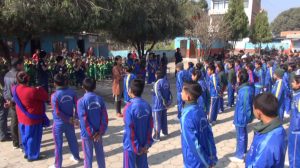
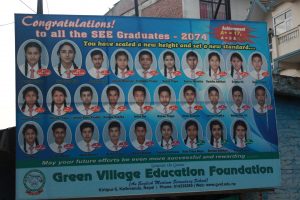
(Left) Students at the morning meeting
(Right) Billboard with students who achieved top marks on their SEEs
(Left) Science class, where students made telephones with yarn
(Right) Sujan Thapa celebrating his test scores
A day in the lives of the children at Rising Lotus Children’s Village
During our last trip, we reported on the children’s daily lives at the facility where they live, Rising Lotus Children’s Village (RLCV). This time, we chose to focus on their school lives.
Two of our staff members spent the night at RLCV. The temperature was quite frigid in the morning and evening, and the rooms were not insulated well enough to keep out the cold. We were reminded of how resilient the children of RLCV were, sleeping in these rooms every day and showering with cold water.
The older children wake up around 6 in the morning to prepare for class. The younger children wake up a little later and began studying as well.
The children are organized and well-accustomed to their morning routine, with the older children guiding the younger ones. The ease with which they helped each other was indicative of the good education that they received at RLCV.
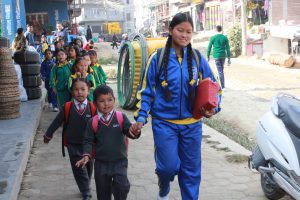
The children walking to school in a row
Click here to see photos of the children and their daily routine! (text in Japanese)
⇒ A day in the lives of the children at RLCV, November 2018